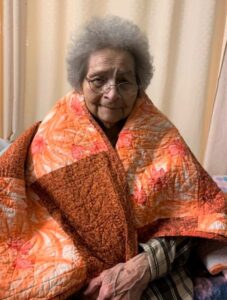M’Chigeeng First Nation citizen receives Quilts for Survivors package

By Sam Laskaris
GORE BAY – A M’Chigeeng First Nation senior is ecstatic with a recent package that arrived in the mail for her.
Helen Crawford, who is 85 and a resident at the Manitoulin Lodge in Gore Bay, is one of the more than 900 recipients thus far of a quilt, courtesy of the Quilts for Survivors group.
The group was started last year by Timmins resident Vanessa Grenier, a Missanabie Cree First Nation member. She was looking to launch a project following news which broke in 2021 that several unmarked children’s graves were being located at former Indian Residential School sites across the country.
Grenier decided to start making quilts for Indian Residential School Survivors. She started a Facebook group looking for others to help make quilts.
Almost 4,000 members are now part of the Quilts for Survivors group. Collectively, they have helped create almost 1,000 quilts which have been distributed across North America.
Crawford, who attended one of the Spanish Indian Residential Schools in Spanish, Ont., had her quilt arrive earlier this month.
“Receiving the quilt was a surprise,” Crawford said through her daughter Gayle Payette. “I was thrilled to see such a beautiful handmade quilt. I read the letter and the card that came with the quilt and my face lit up.”
 And where does Crawford plan to keep the quilt?
And where does Crawford plan to keep the quilt?
“The quilt immediately went on my bed to help keep me warm and comfortable,” she said.
Though she does have some horrific memories of Residential School, Crawford said she does occasionally share some stories.
“I don’t openly talk about it; however, I do respond when asked questions,” she said, adding she witnessed a cousin fall to her death while trying to get away and that other students were not permitted to talk about that incident.
Crawford added that while at the Residential School, she was not allowed to speak Ojibwe or even see her brother, who was also a student there.
“Talking about it is a form of healing for me,” she said. “Sharing provides me the opportunity to be open and provides others the opportunity to understand what I endured.”
Payette, a teacher at Wikwemikong Junior School, said her family was thrilled her mother received the quilt.
“After the Kamloops discovery of children’s graves at a Residential School, I had posted a picture of my mother, saying that this is my survivor,” Payette said. “Later that day, I received a message from my friend Barbara Burrows, telling me about Quilts for Survivors and asked if it would be okay if she and her sisters could make a quilt for my mother. Of course, I said, ‘Absolutely.’”
Payette said she was extremely touched by the gesture.
“Receiving the quilt and presenting it to mom was a momentous occasion for me,” she added. “I had the opportunity to explain to mom that other people are thinking of her and care for her. This quilt is a symbol of love and compassion.”
Payette also said she has been in touch with Grenier and the three women who helped create her mother’s quilt in order to express the family’s gratitude.
The Quilt for Survivors group has its own website which can be viewed here: https://www.quiltsforsurvivors.ca/
Besides looking for new members, the group accepts monetary donations as well as donations of quilt blocks or entire quilts, which will in turn be gifted to residential school survivors.
Request for quilts are also available via the website.


